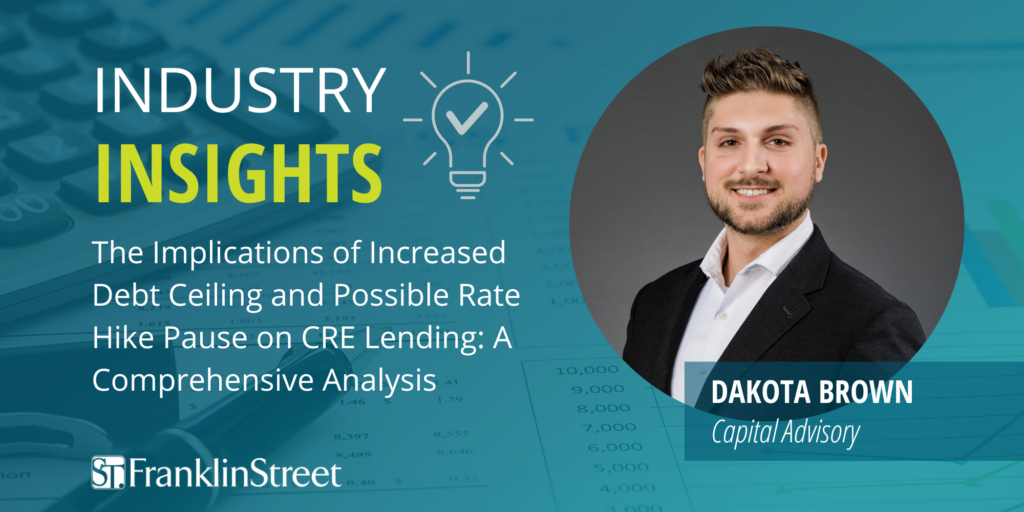By Dakota Brown, Senior Associate of Franklin Street’s Tampa-based Capital Advisory Team
Following the Federal Open Markets Committee meeting held on Wednesday, June 14, the market saw its first pause on rate hikes since March 2022, holding interest rates at the highest they have been in the past 16 years. The Fed Funds Rate increased from 0.25% to 5.25% over a 15-month period, which is the quickest upsurge in rate hikes the U.S. economy has absorbed since 1980. Though frustrating to some, the Fed’s strategy has curbed headline inflation to 4.0% (as of May 2023) from the all-time peak of 9.1% reported in June 2022. The Fed’s (almost) singular focus on inflation has been addressed with some degree of success; however, the brisk pace at which the Fed Funds Rate increased resulted in turmoil in other areas of the economy, most notably, in regional and community banks.
What does this mean for commercial real estate debt and equity transactions?
On the credit side, many banks have been hyper focused on maintaining appropriate liquidity, proper risk management, and avoiding the toxicity that plagued the balance sheets of their peers in recent months. This new philosophical approach to asset and liability balancing combined with concerns over a U.S. default on its ballooning debt load has caused many banks to pull back on their lending appetite across the commercial real estate industry. The most recent raise in the debt ceiling will cause a flood of treasury bills to hit the market, which could exacerbate two increasingly alarming trends from the perspective of a CRE investor – further increases in treasury yields and further tightening in bank lending, since larger banks have an obligation to purchase a portion of these newly issued treasuries.
Tightened lending requirements coupled with increased rates are making it even more difficult for those with maturing bridge loans to refinance. In the past 24 months, many CRE investors resorted to high-octane, high-yielding interim or transitional debt instruments as a way to financially engineer higher cash-on-cash returns. In today’s rate environment, fixed-rate permanent loans from conventional lenders, such as banks, credit unions and life companies are often DSCR constrained to 55-65% loan to value ratios. This leverage ceiling caused by a disconnect in valuations and available cash flows to support the proposed loan payments is making it increasingly more difficult for investors in bridge loan expiration situations to refinance without a material cash injection into the capital stack. The industry refers to this as a “cash in” refinance which is typically frustrating, at best, for an investor and can be catastrophic at the extreme end of the spectrum. This new phenomenon, which many believe we are just in the first inning of, will result in an increase in highly motivated sellers, debt & equity partner forced sales, and loan foreclosures as we enter the second half of 2023.
On the equity side, demand exceeds supply by a seemingly unsustainable rate right now. Non-controlling Limited Partnership and/or Joint Venture equity investments from family offices, private equity funds and institutional REITs have all but dried up for a vast majority of those that identify as private or middle market investors. The “faucet” has not been completely turned to “off,” but the level of liquidity in the market would best be described as a “trickle” relative to where it was from 2020-2022.
What we see moving forward:
- Interest Rates are within 50 – 100 bps of peak levels.
- Continued tightening of CRE credit from conventional debt providers, historically.
- Opportunistic acquisition opportunities in specific pockets of the market – with expansion throughout the market as we hit mid-2024.
- Lack of liquidity in the LP/JV equity market for the near future
- Further correction to asset valuations as a result of elevated rates, operating expenses and lack of credit and liquidity in the market.
We are seeing rates approach their peak levels, though we assume there will continue to be volatility in the market moving towards the end of the year. The Fed has signaled that we may see an additional 25 bps rate hike or two before the end of 2023, despite the temporary pause in rate hikes established at the June meeting. Credit from commercial banks will be less readily available because of stricter adherence to the hard caps being placed on CRE allocations by bank leadership & the regulators. Securitized loan products from debt partners such as Fannie Mae, Freddie Mac, Conduit Investment banks are projected to stay active, though these products are largely reliant on the bond investors of the securitization pool.
Sources:
- The Federal Reserve just raised interest rates again, its fastest stream of hikes in 40 years. 2 important money moves to make now – https://www.marketwatch.com/picks/the-federal-reserve-just-raised-interest-rates-again-its-fastest-stream-of-hikes-in-40-years-2-important-money-moves-to-make-now-1af2d564#:~:text=Today’s%20quarter%2Dpoint%20increase%20marks,rate%20hikes%20in%20four%20decades.&text=The%20Federal%20Reserve%20today%20raised,increased%20it%20in%2040%20years.
- Bureau of Labor Statistics – www.bls.gov
- Fed Chair Powell sees progress on inflation, though not quickly enough – https://apnews.com/article/interest-rates-inflation-federal-reserve-economy-f6318be5023f6e50afc115778c9ec174





